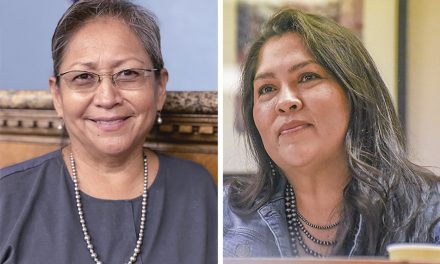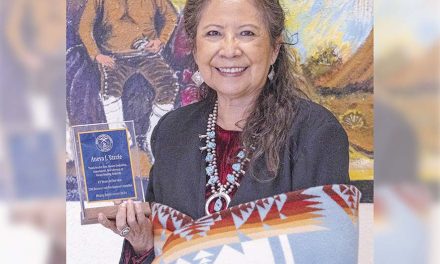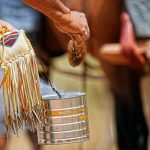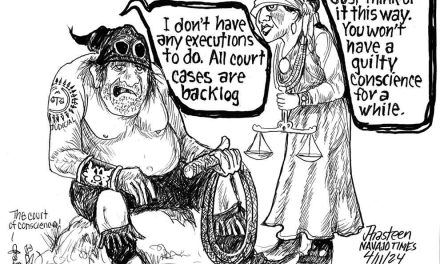
50 Years Ago: Tribe resists requiring tuition for Navajos
We have reported in the past the objections by Navajo officials to a proposal going through the Colorado Legislature that would force Indian students to start paying tuition when they attend Fort Lewis College.
This got a lot of coverage in the Navajo Times back in 1971. The paper ran more than a dozen articles on the subject, most of them making the front page.
While probably all the readers of the Times were strongly supportive of the tribe, editors of the paper came to the conclusion that tribal members were taking that position without knowing why tribal attorneys were adamant that the state had no right to take away free tuition.
To understand why, we have to go back to 1910 when the tribe held the rights to land in Colorado south of Durango. There were few, if any, Navajo families living on the land and the state wanted to acquire it to build a community college on it to serve families who lived in the southwest portion of the state.
The Navajo Tribe had 6,000 acres of land at Hesperus, which would be a perfect location. But when federal officials checked with chiefs within the tribe, they found no support for selling the land to the state.
The headmen wisely figured that as the tribal membership grew, the tribe would need the land more than the $5 an acre that the state was willing to pay for it.
Trying to find something that would entice the tribe to give up the land, the state discovered a speech made about a decade previous that strongly supported higher education for Navajo youth.
So state officials told the tribal chieftains that if the tribe gave the state the land, Indians would not have to pay tuition. The chieftains immediately agreed to the proposal and a contract was signed to that effect.
When members of the Legislature learned in early 1971 that the state was giving away more than $200,000 a year away in free tuition, they contacted the state attorney general and asked him to come up with a legal reason that they could use to start charging Indian students tuition.
And after some research, the attorney general’s office issued an opinion that since the college was relocated in 1958 to Durango, the state was no longer obligated to provide free tuition to Indian students.
Navajo tribal attorneys pointed out, however, that the Navajo Tribe never got the land back and still felt that the state had an obligation to follow the provisions of the contract.
Navajo Tribal Chairman Peter MacDonald said the whole matter was a disappointment because the state failed to recognize the tribe’s role in this.
“I am disappointed because this would have been a perfect opportunity for state officials to sit down with the leaders of the tribe who would have been affected and work out a mutually acceptable solution,” he said.
Wool collapse
Since the Navajo Times reported 50 years ago last week the total collapse of the nation’s wool market, leaving Navajo ranchers with millions of pounds of wool that was basically worthless, the chairman’s office was deluged with hundred of letters asking what he was going to do about the situation.
His first step was to call an emergency session of the Tribal Council and have experts in the field explain to the delegates that the situation was serious.
And it was only going to get worse, not better.
Officials for the national Wool Growers Association said the market was not expected to recover completely and go back to the way it was before 1970. The association itself was urging its members to cut back on the number of sheep they were raising for wool sales and go into other forms of ranching.
But that was the future. What was the tribe going to do to alleviate the suffering of tribal ranchers who were scrambling to find money to live on?
The discussion in the Council lasted most of the day and it was obvious that no one had a solution to the problem. At the end of the session, the Council could only pass a resolution giving MacDonald the authority to do whatever was necessarily to relieve the suffering of the Navajo ranchers.
In an interview the next day, MacDonald said he planned to go in a number of directions to deal with the problem.
His first step, he said, would be to meet with Congressional leaders who represented the Navajo Tribe to see if Congress would be willing to pass an act recognizing the plight of wool growers and provide an annual subsidy to make up for their losses because of the market problems.
Congress was already providing support to farms and ranchers in other areas but tribal officials were told that this may be a long shot since there were not enough sheep ranchers to have any political clout.
Another proposal that had been brought up was for the tribe to appropriate a million dollars to provide relief to those affected. While not reimbursing Navajo ranchers for their compete losses, it would give the families enough to tide them over while they decided how to deal with the problem in the future.
Props to pastor
The Navajo Times gave a shoutout to Rev. H. B. Liebler who served many years looking out for the souls of Navajos living in Utah.
Liebler had created the St. Christopher Mission in Mexican Hat, Utah. He served as the pastor for the mission until 1967 when he retired at the age of 80.
But his retirement did not mean the end of his service to Utah Navajos.
After his retirement, he moved to Hat Rock where he immediately began making plans to build a retreat center about three miles from the Monument Valley Hospital. For three years he had been operating that retreat from a hogan.
In 1970, he decided the retreat needed a chapel and, using his own pension funds as well as donations from others, he built a chapel out of natural rocks from the area.
At 84, he was still going strong.







 Highway 264,
Highway 264, I-40, WB @ Winslow
I-40, WB @ Winslow